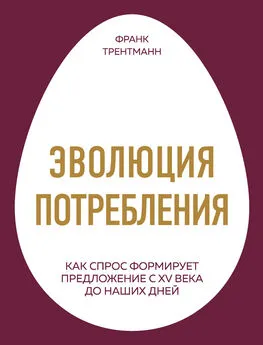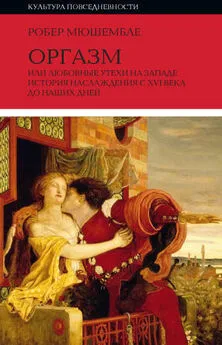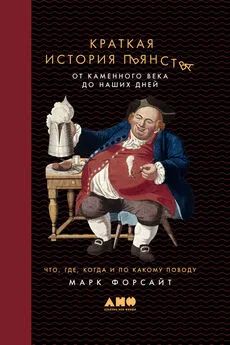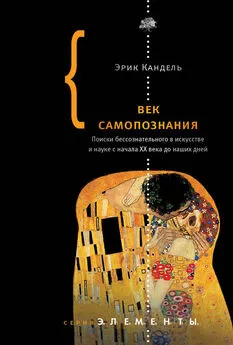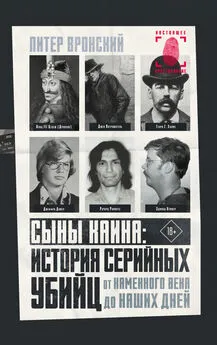Франк Трентманн - Эволюция потребления. Как спрос формирует предложение с XV века до наших дней
- Название:Эволюция потребления. Как спрос формирует предложение с XV века до наших дней
- Автор:
- Жанр:
- Издательство:Литагент 5 редакция «БОМБОРА»
- Год:2019
- Город:Москва
- ISBN:978-5-04-088674-6
- Рейтинг:
- Избранное:Добавить в избранное
-
Отзывы:
-
Ваша оценка:
Франк Трентманн - Эволюция потребления. Как спрос формирует предложение с XV века до наших дней краткое содержание
Эволюция потребления. Как спрос формирует предложение с XV века до наших дней - читать онлайн бесплатно ознакомительный отрывок
Интервал:
Закладка:
46
Patricia Fortini Brown, Private Lives in Renaissance Venice: Art, Architecture and the Family (New Haven, CT, 2004), 149 f.
47
См. Marta AjmarWollheim & Flora Dennis, eds., At Home in Renaissance Italy (London, 2006), в особенности главы «Tableware» («столовая посуда», автор Reino Liefkes) и «Sociability» («общение», автор Marta Ajmar-Wollheim), 254—66, 206—21.
48
Pietro Belmonte, Institutione della sposa (1587), quoted in Ajmar-Wollheim, «Sociability», in Ajmar-Wollheim & Dennis, eds., At Home in Renaissance Italy , 209.
49
Jacob Burckhardt, The Civilization of the Renaissance in Italy (New York, 1860/1958), 364 & 369—70.
50
Ajmar-Wollheim & Dennis, eds., At Home in Renaissance Italy ; а также: Jardine, Worldly Goods .
51
Norbert Elias, The Civilizing Process (Oxford, 1939/1994).
52
Ajmar-Wollheim & Dennis, eds., At Home in Renaissance Italy .
53
Paula Hohti, «The Innkeeper’s Goods: The Use and Acquisition of Household Property in Sixteenth-century Siena», в: Michelle O’Malley & Evelyn Welch, eds., The Material Renaissance (Manchester, 2007), 242—59.
54
Перечень можно найти тут: «L’interno della casa dell’artigiano, e dell’artista nella Venezia del cinquecento», Studi Veneziani (new series) 8, 1984: 126—8
55
Goldthwaite, The Economy of Renaissance Florence , 381.
56
Brown, Private Lives in Renaissance Venice , 173—82.
57
Gasparo Segizzi, умер 1576; см.: Palumbo Fossati, 109—53, особенно 138—45.
58
Goldthwaite, The Economy of Renaissance Florence , 384.
59
Bruno Blondé, «Tableware and Changing Consumer Patterns: Dynamics of Material Culture in Antwerp, 17th—18th Centuries», в: Majolica and Glass from Italy to Antwerp and Beyond , ed. Johan Veeckman (Antwerp, 2002).
60
Jardine, Worldly Goods , 33—4.
61
Goldthwaite, «The Empire of Things».
62
Этот консерватизм был подмечен современниками, такими как Варки Бенедетто, см.: Paolo Malanima, Il lusso dei contadini: consumi e industrie nelle campagne toscane del sei e settecento (Bologna, 1990), 24.
63
Robert C. Davis, Shipbuilders of the Venetian Arsenal (Baltimore, MD, 1991), 100.
64
Elizabeth Currie, «Textiles and Clothing»: Ajmar Wollheim & Dennis, eds., At Home in Renaissance Italy , 349.
65
Evelyn Welch, Shopping in the Renaissance: Consumer Cultures in Italy, 1400–1600 (New Haven, CT, 2005), цитата на с. 234.
66
Welch, Shopping in the Renaissance , 68–72; Гарцони (Garzoni) цитируется на с. 68.
67
Plato, The Republic , Book II, «The Luxurious State» (372—37CE), trans. R. E. Allen (New Haven, CT, 2006), 55—6. См. также: Christopher Berry, The Idea of Luxury (Cambridge, 1994); William Howard Adams, On Luxury: A Cautionary Tale (Washington, DC, 2012, 1st edn).
68
Matthew 6:19–21 (King James Bible). См. также: The Works of Aurelius Augustine, The City of God (Edinburgh, 1871).
69
Patricia Allerston, «Consuming Problems: Worldly Goods in Renaissance Venice» из: O’Malley & Welch, eds., The Material Renaissance , 22.
70
1564, цитата в: O’Malley & Welch, eds., The Material Renaissance , 19.
71
Vincent Cronin, The Florentine Renaissance (London, 1972), 288f.
72
This paragraph draws on Patricia Fortini Brown, «Behind the Walls: The Material Culture of Venetian Elites» из: John Martin & Dennis Romano, Venice Reconsidered: The History and Civilization of an Italian City-state, 1297–1797 (Baltimore, MD, 2000), цитата на 324 & 326.
73
Paola Pavanini, «Abitazioni popolari e borghesi nella Venezia cinquecentesca», Studi Veneziani (new series) 5, 1981: 63—126, особенно 111—12, 125—6.
74
Ulinka Rublack, «Matter in the Material Renaissance», Past & Present 219, 2013: 41–84.
75
Kent Roberts Greenfield, Sumptuary Law in Nürnberg: A Study in Paternal Government (Baltimore, MD, 1918), 109.
76
Greenfield, Sumptuary Law in Nürnberg .
77
Sheilagh Ogilvie, «Consumption, Social Capital and the «Industrious Revolution» in Early Modern Germany», Journal of Economic History 70, no. 2, 2010: 287–325, 305.
78
24 Hen. VIII. C. 13 (1532—3), из: Statutes of the Realm , Vol. III: 1509—45 (London, 1817), eds. T. E. Tomlins & W. E. Taunton, цитата со с. 430.
79
Frances Elizabeth Baldwin, Sumptuary Legislation and Personal Regulation in England (Baltimore, MD, 1926), 231f.
80
Greenfield, Sumptuary Law , 109, 128—30.
81
Madeline Zilfi, «Goods in the Mahalle»: Consumption Studies and the History of the Ottoman Empire, 1550–1922 , ed. D. Quataert (New York, 2000).
82
Roy Porter, «Consumption: Disease of the Consumer Society?»: John Brewer & Roy Porter, eds., Consumption and the World of Goods (London & New York, 1993), 58–81; Dominik Schrage, Die Verfügbarkeit der Dinge: Eine historische Soziologie des Konsums (Frankfurt am Main, 2009), 43–51; Frank Trentmann, «The Modern Genealogy of the Consumer: Meanings, Identities and Political Synapses»: Consuming Cultures, Global Perspectives: Historical Trajectories, Transnational Exchanges , eds. John Brewer & Frank Trentmann, (Oxford & New York, 2006), 19–69.
83
Alan Hunt, Governance of the Consuming Passions: A History of Sumptuary Law (Basingstoke, 1996), цитата со с. 73.
84
Andreas Maisch, Notdürftiger Unterhalt und gehörige Schranken: Lebensbedingungen und Lebensstile in württembergischen Dörfern der frühen Neuzeit (Stuttgart, 1992), 366—70.
85
Hans Medick, Weben und Ueberleben in Laichingen, 1650–1900: Lokalgeschichte als allgemeine Geschichte (Göttingen, 1996), особенно 387–437.
86
Daniel Roche, The Culture of Clothing: Dress and Fashion in the «Ancien Régime» ( Cambridge, 1989/1994, 56.
87
Sheilagh C. Ogilvie, A Bitter Living: Women, Markets and Social Capital in Early Modern Germany (Oxford, 2003); Ogilvie, «Consumption, Social Capital and the «Industrious Revolution» in Early Modern Germany».
88
Matteo Ricci, China in the Sixteenth Century: The Journals of Matthew Ricci: 1583–1610, trans. from the Latin by Louis J. Gallagher (New York, 1583–1610/1953), 25, 550.
89
Semedo, The History of That Great and Renowned Monarchy of China (1655; 1st Portugese edn, 1641), https://archive.org/down-load/historyofthatgre00seme/historyofthatgre00seme.pdf.
90
Timothy Brook, The Confusions of Pleasure: Commerce and Culture in Ming China (Berkeley, CA, 1998), 123 и дальше.
91
Semedo, History of That Great and Renowned Monarchy of China , 23.
92
Brook, Confusions of Pleasure , 198. См. также: Bozhong Li, Agricultural Development in Jiangnan, 1620–1850 (Basingstoke, 1998).
93
Sarah Dauncey, «Sartorial Modesty and Genteel Ideals in the Late Ming»: Daria Berg & Chloe Starr, The Quest for Gentility in China: Negotiations beyond Gender and Class (London, 2007), 137.
94
Daria Berg, Women and the Literary World in Early Modern China, 1580–1700 (London, 2013).
95
Wu Jen-shu, Elegant Taste: Consumer Society and the Literati in the Late Ming (Taipei, 2007). Wu Jenshu, «Ming—Qing Advertising Forms and Consumer Culture» (готовится к выходу), с благодарностью У Джен Шю за возможность изучить его работу.
96
Brook, Confusions of Pleasure , 6, 220.
97
См.: Clunas, Superfluous Things , 37 f.
98
The Plum in the Golden Vase, or Chin P’ing Mei , trans. David Tod Roy (Princeton, NJ, 1618/1993), Vol. I, 126, 133—4.
99
Brook, Confusions of Pleasure , 153—4.
100
По мнению Шеня Бана (Shen Bang), на похороны могло уйти до тысячи лянов (чиновник низкого ранга зарабатывал 35 серебряных лянов в год); см. Dauncey «Sartorial Modesty»: Berg & Starr, The Quest for Gentility in China , 134—54.
101
PingTiHo, «The Salt Merchants of Yang-chou», Harvard Journal of Asiatic Studies 17, 1954: 130—68, цитата на с. 156.
102
Werner Sombart, Luxus und Kapitalismus (Munich, 1912), 96—7.
103
Yue Meng, Shanghai and the Edges of Empires (Minneapolis, MN, 2006), 143—6. См. также: Antonia Finnane, «Chinese Domestic Interiors and «Consumer Constraint» in Qing China», Journal of the Economic and Social History of the Orient 27, 2014: 112—44.
104
Цитата из: Brook, Confusions of Pleasure , 144. См. также: Kenneth Pomeranz, The Great Divergence: China, Europe and the Making of the Modern World Economy (Princeton, NJ, 2000); Roy Bin Wong, China Transformed: Historical Change and the Limits of European Experience (Ithaca, NY, 1997); Hanchao Lu, «Arrested Development: Cotton and Cotton Markets in Shanghai, 1350–1843» из: Modern China 18, no. 4, 1992: 468—99.
105
Clunas, Superfluous Things , 35, 38, 44.
106
Цитата из: Clunas, Superfluous Things , 74.
107
Clunas, Superfluous Things , 111.
108
See Kathlyn Maurean Liscomb, «Social Status and Art Collecting: The Collections of Shen Zhou and Wang Zhen», Art Bulletin 78, no. 1 (1996): 111—35.
Читать дальшеИнтервал:
Закладка:
